
Compliments of:
Colete Stewart
TheFoodChopper.com
Cast Iron Cookware: Made to Last, Makes Great Meals Too
Table of Contents
Int
roduction
....................................................................................................................................................... . . . . . . .3
Be
yond Skillets: 4 Must-Have Cast Iron Cookware Pieces
.................................................................................... .4
How to Care for Your Cast Iron Cookware
..................................................................................................................................................................................
5
4 Co
mmonly Asked Questions About Cast Iron Cookware
.....................................................................................
6
O
ven-Roasted Whole Chicken
........................................................................................................................... . . . . . .9
Ca
st Iron Rosemary Roasted Red Potatoes
................................................................................................... . . . . . . . . .1 1
Ca
ramelized Onions
........................................................................................................................................ . . . . . . .14
S
weet Cornbread with Golden Brown Crust
.............................................................................. . . . . . . . . . . . . . . . . . . . . . . . . . . .18
Ca
st Iron Brownies
..................................................................................................................... . . . . . . . . . . . . . . . . . . . . . . . . . . .22
Ba
nana Chocolate Chip Pancakes
...................................................................................................................... . . . .25
D
eep Dish Pizza with Barbeque Chicken and Caramelized Onions
..................................................................... .26
P
an-Seared Jumbo Sea Scallops
.................................................................................................... . . . . . . . . . . . . . . . . . . . . . . . .28
S
izzling Marinated Steak Fajitas
................................................................................................ . . . . . . . . . . . . . . . . . . . . . . . . . . .29
S
uper Easy Pan-Seared Rib Eye Steak
.......................................................................................... . . . . . . . . . . . . . . . . . . . . . . . .31
©Copyright 2014 ♦ TheFoodChopper.com ♦ All Rights Reserved | Page 2 of 31
Cast Iron Cookware: Made to Last, Makes Great Meals Too
Introduction
Once you start cooking with cast iron, odds are you'll end up loving it. For starters, it's a true culinary work horse able to go from cooktop to oven to outdoor grill to blazing campfire with ease. No matter what's on the menu, you know it's going look and taste better when you use your favorite cast iron cookware.
Here are a 5 Reasons to Love Your Cast Iron Cookware:
1. It's Versatile. Cast iron cookware can be used in many different ways: on top of the stove, in the oven, under the broiler, on the grill, or even over an open campfire. This versatility saves you both time and money because you don't have to buy or wash a bunch of extra pots and pans.
For example, to make a big pot roast in a single pan, pull out your cast iron Dutch oven to brown the meat, then add the remaining ingredients before placing in the oven to cook.
Who needs a big roasting pan? Just take out your largest cast iron skillet and roast a whole chicken in it. You can also sear steaks on top of the stove and then put it them in the oven to finish cooking without needing to dirty another dish.
2. Economical. A basic piece of cast iron cookware is usually a steal, whether you buy it new or at a yard sale.
The simplest form, called 'raw' cast iron (the black color), is what you might envision on a campfire. There are also more colorful enameled varieties, but they tend to cost a lot more. Fortunately, some well known lines of old-fashioned cast iron cookware have come out with their own enameled versions that rivals the designer labels.
For the most part, if you want a good, solid piece of cookware without spending a lot of money, cast iron is the right place to start.
3. Durable. This old-fashioned cookware is nearly indestructible. Now, that doesn't mean you can't damage the seasoned finish, but even if you do - it can be fixed in most cases. First, try cooking some bacon or other fatty food in it. If that doesn't give the results you want, you can always re-season the pan to restore the finish to its previous luster.
Know you know why cast iron cookware is handed down for generations - it lasts forever!
4. Practical. Have you ever started cooking a dish on your cooktop only to realize you need to pop it under the broiler to finish it?
If you have ever had to transfer food from one piece of cookware to another just to complete a recipe, you know what a pain that can be. If you are using a regular skillet, you need to worry about whether or not the handle will melt or if the whole thing will crack from the heat.
Unlike regular pots and pan or fancy specialty cookware, cast iron is no-nonsense. Which means you don't have to think about anything but your recipe and gathering everyone around the table.
©Copyright 2014 ♦ TheFoodChopper.com ♦ All Rights Reserved | Page 3 of 31
Cast Iron Cookware: Made to Last, Makes Great Meals Too
5. Sentimental. Cast iron has been a mainstay in kitchens for generations. As a result, cast iron is often associated with warm, happy memories of delicious meals shared with close family and friends. Perhaps you have fond memories from your childhood of delicious Sunday breakfasts at grandma's house or of your mom's favorite comfort foods hot from the oven. Or maybe you had the chance to hang a cast iron pot over an open fire before enjoying a hot bowl of chili or stew.
Whatever your personal memories of cast iron may be, chances are your own frequently used pieces will
become a treasured part of your family's history, which is truly something to love.
Beyond Skillets: 4 Must-Have Cast Iron Cookware Pieces
Cast iron skillets are so easy to love. Whether inherited from a beloved grandmother, found at a bustling flea market, or purchased brand new, the origin of these durable and dependable skillets doesn’t really matter. Once one makes its way into your home, it will soon become a treasured kitchen staple.
Fortunately, the beauty of cast iron doesn’t end there. In fact, there are many affordable cast iron pieces available that are just as wonderful as your favorite skillet.
Here are four other great cast iron cookware pieces:
1. Dutch Oven - No kitchen is complete without a cast iron Dutch oven. There are many choices available, especially now with the increasing popularity of the enamel finishes. Although the colorful designer styles can be pricey, you can still find the simple 'campfire' or 'raw' varieties of cast iron at a very reasonable price.
Both the designer and raw styles work extremely well - after all, the quality is in the cast iron, not the color!
When you shop, choose a Dutch oven that is heavy, with sturdy handles, and a tight-fitting cast iron or heavy glass lid. A good cast iron Dutch oven can be used on top of the stove to make soups and stews or it can be used in the oven to make roasts and casseroles. You can even take a “raw” version on your next camping trip to whip up some delicious meals over your campfire.
Aside from your cast iron skillet, your Dutch oven will be among your most often used cookware pieces.
2. Grill/Griddle Combo – Although you may long for a stove with a built-in grill/griddle combination, it may not be a realistic option in the near future. However, you may be surprised to discover how easy and fun it is to cook with a cast iron version. Just heat up your cast iron griddle and you will feel like a short-order cook in no time!
Cast iron is so versatile, you’ll soon be frying up crispy bacon, golden brown pancakes, and perfectly done eggs without having to wash several pans or mess around with a bunch of specialty appliances. Plus, the grill side makes those nice grill marks that make everything you cook look so wonderful. For some reason, food that looks good seems to taste better, too.
3. Muffin and Loaf Pans – The best part of making cornbread in a cast iron skillet is the golden crust that forms around the outside of the pan. When you use cast iron muffin or loaf pans, you’ll end up with even more
©Copyright 2014 ♦ TheFoodChopper.com ♦ All Rights Reserved | Page 4 of 31
Cast Iron Cookware: Made to Last, Makes Great Meals Too
of that golden crusty goodness.
In addition, you can use cast iron muffin pans for all sorts of muffins and other individual serving size dishes.
Plus switching to cast iron loaf pans for bread results in consistently golden brown crusts with no scorched bottoms.
4. Fajita Serving Platters - To re-create that restaurant-style sizzle when your fajita or steak comes to the table, you can't beat individual cast iron serving platters. Just heat the platters in a hot oven, and when your meal is ready to serve, carefully pull the platters from the oven and plate them up for that mouth-watering sizzle everyone loves.
You can also find sizzle platters with heat-resistant carriers so all you have to worry about is making enough food so you don’t run out when everyone asks for more!
Besides the fun restaurant-quality presentation you can achieve with these individual serving platters, they offer the added bonus of keeping your food warmer longer. This is a great idea when you're cooking and serving outdoors. No more chilled plates on the picnic table, which makes sizzle platters both fun and practical.
A good set of cast iron skillets is a great starting point for every kitchen. But, once you get your basic skillets seasoned just right, isn't it time to expand your horizons?
These four versatile pieces will open up a whole new world of cast iron cooking in no time. From roasts to soups to breads to the lazy weekend morning breakfast extravaganza, cast iron cookware does it all - and does it deliciously!
How to Care for Your Cast Iron Cookware
Over time, cast iron cookware develops a thin protective coating known as “seasoning” from the natural fats and oils associated with the cooking process. This coating fills in all the nooks and crannies inherent in the pan metal to create a smooth, uniform surface.
This seasoning is what gives cast iron cookware its wonderful non-stick quality.
Today, most new cast iron cookware comes with this protective coating or “seasoning” already on them. If the package has “pre-seasoned” printed on it, your new pan should be ready for use because the manufacturer has already completed the initial seasoning process for you.
When you buy a brand new pre-seasoned cast iron skillet, all you need to do is rinse it out in hot water and dry completely by placing on your cooktop over medium-high heat. Make sure the entire surface is dry before putting away because cast iron can and will rust if water is left sitting on its surface.
After cooking with your new cast iron skillet, wash it by hand in hot water right away.
©Copyright 2014 ♦ TheFoodChopper.com ♦ All Rights Reserved | Page 5 of 31
Cast Iron Cookware: Made to Last, Makes Great Meals Too
Avoid putting your skillet in the dishwasher or soaking it in water
overnight due to the potential for rust.
Instead, once the pan cools to the touch, rinse it under hot water while using a dishcloth or soft-bristled nylon brush to remove cooked-on particles. Also avoid using any harsh soaps, detergents, or metal scouring pads and scrapers as these items can damage or remove the seasoning.
How to Re-Season Your Cast Iron Skillet
If your seasoned cast iron cookware loses its sheen for whatever reason, you may need to re-season it to get it back into tip-top shape.
If you search online for how to re-season a cast iron skillet, you may be a bit overwhelmed by all the different points of view out there regarding the best methods and types of oil to use. For example, there is a lot of debate about what oil to use due to the different smoke points associated with each type of oil and the release of unhealthy free radicals caused by using oils with too-low smoke points. As a result, flaxseed oil is often suggested as an ideal oil to use due to its high smoke point.
According to Lodge, a leading manufacturer of cast iron cookware, the proper way to re-season their products is to start by preheating your oven to 350 – 400˚. While it is heating, wash the pan with hot, soapy water and a stiff brush. (It’s okay to use harsher soap and a stiff brush for this because you’re not trying to protect the original seasoning at this point).
Once clean, rinse and dry completely before applying a very thin coat of melted solid vegetable shortening or other cooking oil of your choice. Place the pan upside down on the upper rack of your preheated oven, with a metal cooking sheet under it to catch any drips. Leave pan in hot oven for at least an hour. Turn oven off and allow the skillet to cool completely while still inside the oven. Remove pan from oven and if the coating isn’t as consistent as you’d like, repeat this process until the desired sheen is achieved.
Following these easy tips on how to care for your cast iron cookware will help keep your pieces in great shape.
A minimal investment of time and effort on your part will yield delicious meals for you and your family for years to come.
4 Commonly Asked Questions About Cast Iron Cookware
Whether you're new to cast iron cooking or have been using your favorite pieces for years, chances are you may have a few questions about how to use and care for your cast iron.
Here are four common questions about cast iron cookware:
1. Question: I bought a new cast iron skillet and it says it's "pre-seasoned" and "ready to use." Is it really? I've heard so much about the proper seasoning of cast iron, this just doesn't seem right.
Answer: This is a tricky question two-part question which actually can be answered both "yes" and "no."
Yes, you can cook in new "pre-seasoned" cast iron cookware without going through any seasoning process.
©Copyright 2014 ♦ TheFoodChopper.com ♦ All Rights Reserved | Page 6 of 31
Cast Iron Cookware: Made to Last, Makes Great Meals Too
However, it is not truly “ready to use.”
You should still rinse your new cast iron piece in hot water to remove any of the dust or dirt it picked up on the store shelf. Then, dry it completely by heating over a burner set to medium-high heat for about one minute.
Once it is completely dry, allow your pan to cool before lightly coating with a good food-quality oil or fat with a high smoke point.
Adding a light coat of oil after each use will help build up an even
better patina on your pan surface over time.
2. Question: I had a really nice seasoning on my cast iron skillet, but now it seems to be peeling and chipping.
What happened?
Answer: There are a few things that can cause this. The most common causes are washing your skillet with a harsh soap or letting it soak overnight in the sink. Both of these actions can soften the finish and cause it to peel off or disintegrate.
The recommended method for washing your cast iron is to give it a quick rinse in hot water, wipe with a paper towel, and dry thoroughly on a hot burner. This will maintain the cast iron patina.
Cooking highly acidic foods or using metal cooking utensils can also damage the patina on your cast iron pieces. For instance, if you are making something with a lot of tomatoes, you may see some distress or dulling on the finish. To combat the reaction that acidic foods have on the finish, be sure to cook other types of food in the same pan often.
Fortunately, if the patina is very well established, a little acid isn't going to hurt it. It's really in those first stages that you might have some pitting and softening. Just watch it closely and avoid acidic foods as much as possible in newly seasoned cookware.
3. Question: I recently pulled out my grandmother's old cast iron skillet and noticed that rust had formed where the pots were stacked together. Is it ruined?
Answer: No, definitely not. While it can be discouraging to find rust on your favorite pieces of cast iron, it is not impossible to remove.
There are a lot of remedies out there, but the most natural methods for rust removal are often the best and safest.
Simply sprinkle salt onto the area, cut a lemon in half, and rub the lemon over the salt. Let the cast iron sit out to dry, then rinse. Repeat the process to remove any remaining spots of rust.
The nice thing about this method is you are not going to hurt the pan, and you can repeat it as often as necessary. Be wary of any suggestions that a spray-on oven cleaner is the only remedy. A little salt and lemon will remove the rust without severely stripping whatever patina you have already built up.
4. Question: I really want to wash my cast iron cookware, but I keep hearing people say I should just wipe it out to keep the finish nice. Isn't that just asking for trouble with germs?
©Copyright 2014 ♦ TheFoodChopper.com ♦ All Rights Reserved | Page 7 of 31

Cast Iron Cookware: Made to Last, Makes Great Meals Too
Answer: In a perfect world, soap would never touch your cast iron cookware. However, there are times when a little mild dish soap on a sponge is needed. The key is to not overdo it with harsh detergents or abrasive surfaces so you don’t damage the patina.
If you're worried about germs, soap and water isn't the only solution. Heat your cast iron over high heat and add some oil to the pan. Allow the oil to heat to just below the smoke point. Then, remove from the heat, let cool and wipe with a paper towel. No germs will survive through this process.
If you still want a water bath, add water to the cookware and bring it to a boil, then pour it out, and dry on a hot burner, wiping the cookware clean. If you absolutely must use soap, then do so sparingly. Wipe the cookware with a sponge (never a scrubber) and a dab of dish soap. Then, rinse and dry thoroughly. Be sure to brush on some oil or grease after each cleaning, regardless of what method you use.
Keep in mind, there are different methods to care for your cast iron cookware depending on the types of foods you cook in them. For example, if you cook a lot of chili or other acidic food, you may have to season your cast iron more often. If you use a skillet just to fry eggs and bacon, you can probably just wipe it out with a paper towel and you'll be good to go.
With a little practice, you'll know exactly what your cast iron needs to perform perfectly every time.
Find the best deals on Cast Iron Cookware here. But Make sure to check this page for any coupons on this cookware before you buy: Check for Coupon
Enjoy your 10 Delicious Cast Iron Cooking Recipes below.
©Copyright 2014 ♦ TheFoodChopper.com ♦ All Rights Reserved | Page 8 of 31
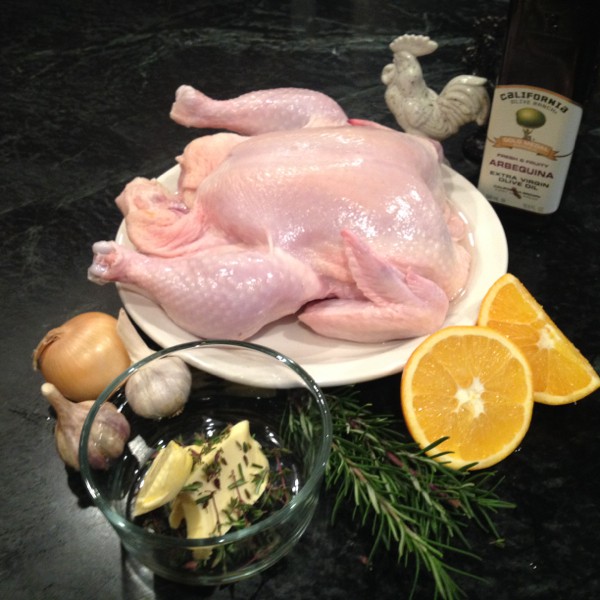
Cast Iron Cookware: Made to Last, Makes Great Meals Too
Oven-Roasted Whole Chicken
Ingredients:
1 whole roasting chicken, approximately 4-5 pounds
1 large yellow onion or 2 medium, cut into uniformly thick slices
1 whole orange, cut into quarters
8-10 cloves garlic, crushed and skins removed
4 tablespoons butter, cut into slices
2 sprigs fresh rosemary, leaves removed and chopped, plus 3 whole sprigs
3 sprigs fresh thyme, leaves removed, plus 3 whole sprigs
2 tablespoons extra virgin olive oil
salt and pepper, to taste
1 batch Oven-Roasted Red Potatoes* (optional)
Directions:
Preheat oven to 425˚
Remove giblets from chicken cavity and discard. Rinse chicken and pat dry with paper towels.
If desired, prepare one batch of Oven-Roasted Red Potatoes in a 12” pre-seasoned cast iron skillet as directed.
Once potatoes have been browned on the cooktop, push them to the outer edge of the pan and placed sliced onions in the center. Otherwise, omit the potatoes and just place sliced onion on bottom of skillet.
Set chicken on top of onions and fill cavity with sliced oranges, garlic cloves and whole sprigs of rosemary and
©Copyright 2014 ♦ TheFoodChopper.com ♦ All Rights Reserved | Page 9 of 31
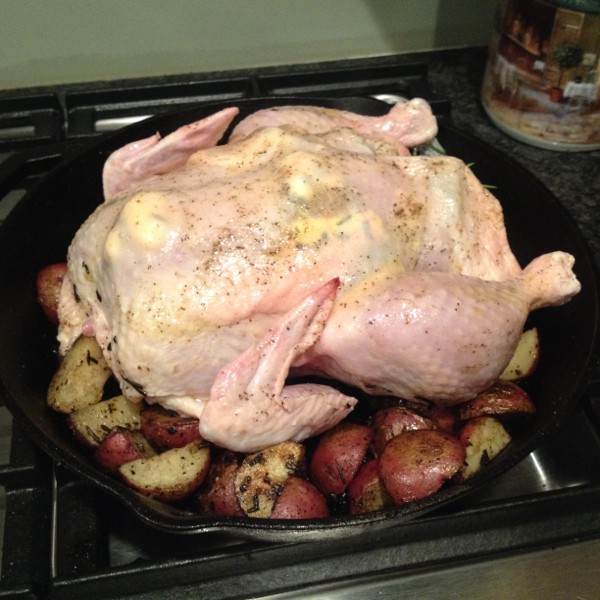
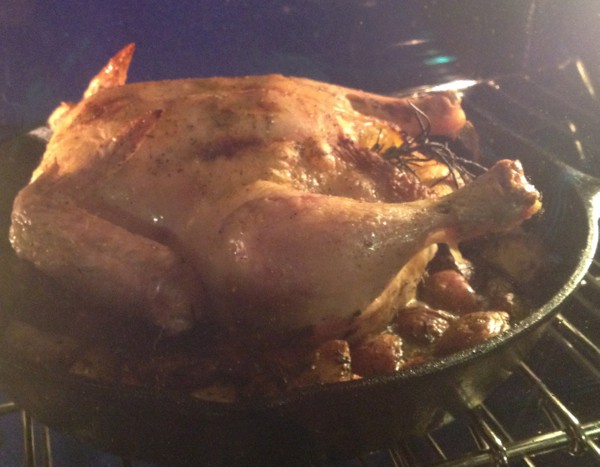
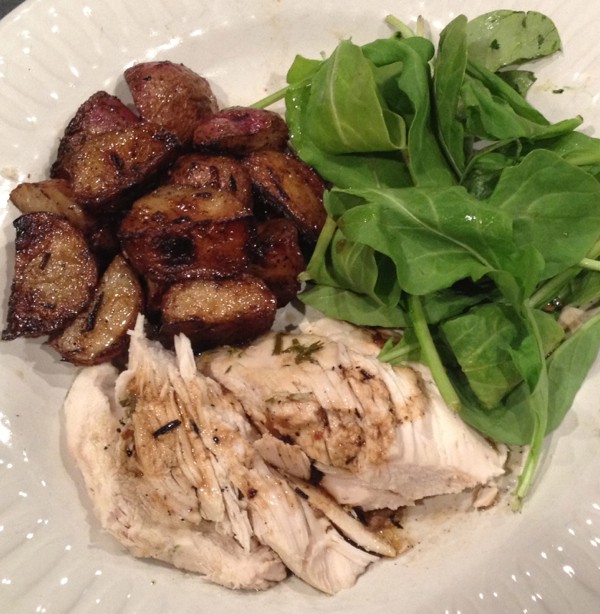
Cast Iron Cookware: Made to Last, Makes Great Meals Too
thyme. For a nicer appearance, tie legs together with kitchen twine.
Add chopped rosemary and thyme leaves to a flat plate and press butter slices into the herb mixture. Repeat on the other side. Use a knife to separate the skin from the breast meat and slide the herbed butter slices in between.
Drizzle olive oil over top of chicken breast and use fingers or pastry brush to coat exposed surface. Season generously with salt and pepper, to taste.
Place skillet in oven and roast for approximately 1 hour or until juices run clear when you cut into the area near the base of the thigh. Actual cooking time will vary depending on how large the bird is and individual oven settings.
Remove skillet from oven, tent with aluminum foil and allow to rest for 10 to 15 minutes before serving.
©Copyright 2014 ♦ TheFoodChopper.com ♦ All Rights Reserved | Page 10 of 31
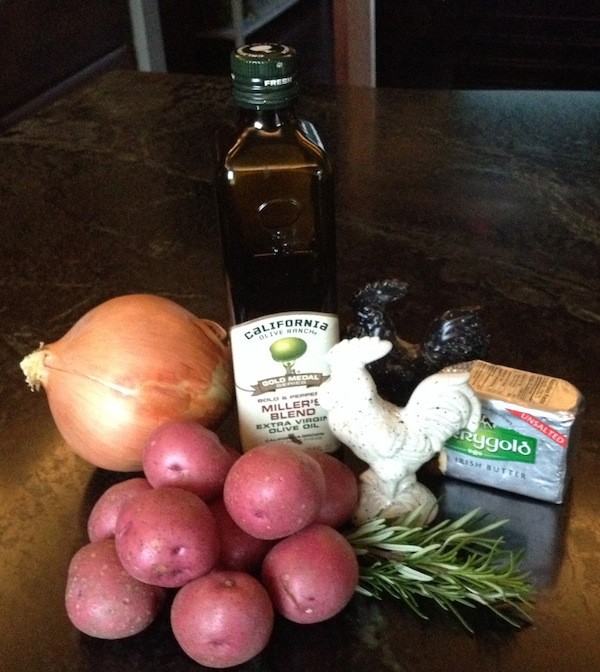
Cast Iron Cookware: Made to Last, Makes Great Meals Too
Cast Iron Rosemary Roasted Red Potatoes
Ingredients:
2 tablespoons butter
2 tablespoons extra virgin olive oil
3 sprigs fresh rosemary
2 tablespoons onion, finely minced
2 pounds red potatoes
sea salt and pepper, to taste
Directions:
Preheat oven to 425˚
Remove rosemary leaves from woody s










